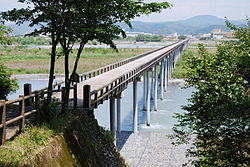Shimada, Shizuoka
Shimada
島田市 | |
|---|---|
 Hōrai Bridge in Shimada | |
 Location of Shimada in Shizuoka Prefecture | |
| Coordinates: 34°50′10.6″N 138°11′33.8″E / 34.836278°N 138.192722°E | |
| Country | Japan |
| Region | Chūbu (Tōkai) |
| Prefecture | Shizuoka Prefecture |
| Government | |
| • Mayor | Someya Kinuyo |
| Area | |
| • Total | 315.70 km2 (121.89 sq mi) |
| Population (March 2018) | |
| • Total | 96,674 |
| • Density | 306/km2 (790/sq mi) |
| Time zone | UTC+9 (Japan Standard Time) |
| Symbols | |
| • Tree | Osmanthus |
| • Flowers | Rose, azalea |
| • Bird | Blue-and-white flycatcher |
| Phone number | 0547-37-8200 |
| Address | 1-1 Chūō-chō, Shimada-shi, Shizuoka-ken 427-8501 |
| Website | www |

Shimada (島田市, Shimada-shi) is a city located in Shizuoka Prefecture, Japan.
The city, which covers an area of 315.7 square kilometres (121.9 sq mi), had an estimated population in March 2018 of 96,674, giving a population density of 306 persons per km2.
Geography
Shimada is located in the Shida Plains of west-central Shizuoka Prefecture. It is located on both banks of the Ōi River. The area enjoys a warm maritime climate with hot, humid summers and mild, cool winters.
Surrounding municipalities
Shizuoka Prefecture
- Aoi-ku, Shizuoka
- Tenryū-ku, Hamamatsu
- Fujieda
- Kakegawa
- Kikugawa
- Makinohara
- Yaizu
- Yoshida, Haibara District
- Kawanehon, Haibara District
- Mori, Shuchi District
History
Shimada (Kanaya) began as an outlying fortification to Kakegawa Castle erected by Yamauchi Kazutoyo in the Sengoku period to control the crossing of the Ōi River. In the Edo period, Kanaya-juku and Shimada-juku developed as post towns on the Tōkaidō highway connecting Edo with Kyoto. The area was mostly tenryō territory under direct control of the Tokugawa shogunate with a daikansho based at a Jinya located within Shimada-juku. As the Tokugawa shogunate forbade the construction of any bridge or establishment of a ferry service on the Ōi River for defensive purposes, travellers were often detained at either Shimada or Kanaya for days, sometimes weeks, waiting for the river levels to fall to fordable levels. The first bridge (the Hōrai Bridge) across the river connected these two towns in 1879, after the Meiji Restoration.
During the cadastral reform of the early Meiji period in 1889, Kanaya Town was created within Haibara District, and Shimada Town within Shida District. On April 16, 1889, the two towns were connected by rail, with the opening of Shimada Station on the Tōkaidō Main Line.
Shimada was elevated to city status on January 1, 1948. On January 1, 1955, it annexed neighboring Rokugo Village, Otsu Village, Daichō Village and a portion of Ikumi Village. On June 1, 1961 it further expanded through annexation of Hatsukura Village.
On May 1, 2005, the town of Kanaya (from Haibara District) was merged into Shimada.
On April 1, 2008, the town of Kawane (also from Haibara District) was also merged into Shimada.
On March 15, 2012, the city became the second municipality, after Tokyo, outside Tōhoku to accept debris from the 2011 Tōhoku earthquake and tsunami for disposal in the town's incinerators. Other cities had been reluctant to accept debris from the disaster, in spite of being asked to help recovery efforts, because of fears that the debris were contaminated by radiation from the Fukushima Daiichi nuclear disaster.[1]
Economy
The economy of Shimada is primarily agricultural, with green tea as the main crop. Light industries of Shimada include factories for the production of automobile components.
Education
Shimada has 18 elementary schools, nine middle schools and five high schools, as well as one special education school.
Transportation
Railway
Highway
Airport
International relations
Shimada is twinned with the following cities.
 Himi, Toyama, Japan, from April 15, 1987
Himi, Toyama, Japan, from April 15, 1987 Huzhou, Zhejiang, China,[2] from May 1987
Huzhou, Zhejiang, China,[2] from May 1987 Brienz, Switzerland,[2] from August 10, 1996
Brienz, Switzerland,[2] from August 10, 1996 Richmond, California, United States,[3] from December 1961. There is currently a student exchange program between Shimada and Richmond.
Richmond, California, United States,[3] from December 1961. There is currently a student exchange program between Shimada and Richmond.
Local attractions
Notable people from Shimada
- Masafumi Gotō - musician
- Tarzan Goto - professional wrestler
- Yukihiro Ikeda - musician
- Takahiro Kawamura - professional football player
- Kayoko Kishimoto - actress
- Sho Naruoka - professional football player
- Hirotoki Onozawa - professional rugby player
- Masaki Yamamoto - professional football player
References
- ^ Kyodo News, "City of Shimada to accept debris from Iwate to help reconstruction", Japan Times, 16 March 2012, p. 1.
- ^ a b "International Exchange". List of Affiliation Partners within Prefectures. Council of Local Authorities for International Relations (CLAIR). Archived from the original on 13 January 2016. Retrieved 21 November 2015.
{{cite web}}: Unknown parameter|deadurl=ignored (|url-status=suggested) (help) - ^ "US-Japan Sister Cities by State". Asia Matters for America. Honolulu, HI: East-West Center. Retrieved 20 November 2015.



